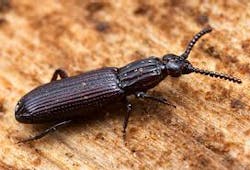Beetles Not Responsible for Severe Wildfires
ALAMOSA — Popular notions to the contrary, bark beetle infestations do not equal more severe fires, according to a University of Colorado researcher.
The San Juan Mountains have seen plenty of both in recent years and Robbie Andrus, a doctoral student in geography, found the 120,000-acre West Fork Fire did damage for other reasons.
He told the Rio Grande basin roundtable Tuesday that dry, hot weather, topography and stand structure had far more to do with whether a fire would kill trees.
“Fire severity was very similar in beetle-killed and non-beetle-killed areas,” he said. “Essentially, from an ecological perspective, fire didn’t burn differently in those areas.”
His research included the West Fork burn scar as well as others in the San Juans where the spruce beetle had not been present.
All told, the research was conducted on 140 plots.
In looking at Englemann spruce infested by beetles, he focused on sections of the forest where trees had reached a gray stage, meaning they had dropped their needles but were not more than five years into the epidemic at the time of the fires.
Dan Dallas, superintendent of the Rio Grande National Forest, told the roundtable the study’s findings were not surprising, given that spruce are not a fire-resistant tree.
“We basically know that if fire of any sort gets up against a spruce tree, it’s going to kill it,” he said.
But Dallas noted that the U.S. Forest Service measures fire severity by how badly a fire scorches the soil.
Extremely burnt soil, which amounted to about 11 percent on the West Fork scar, can prevent the return of spruce stands.
Andrus did not dispute the importance of soil in determining severity but he said it would have been difficult to measure.
Dallas also told the roundtable there were concerns about the threat posed by the beetle-killed trees once they begin to fall, a process that can take as long as 50 years.
While that was not in the scope of Andrus’ study, Dallas worried about a fire hitting a section of the forest covered in downed spruce trees. “You have way more potential for damaging the
soil,” he said. The Rio Grande has 588,000 acres of beetle- infested spruce stands, most of which have yet to fall.
Dallas also added that opponents of Forest Service thinning operations had cited Andrus’ work as a reason not to do thinning projects.
Andrus, a former wildlands firefighter, said he did not agree with that sentiment when it came to doing work that would protect homes or other structures. But he does believe that logging in remote sections of beetle-killed forest would not have an impact on the likelihood or severity of future fire.
———
©2016 The Pueblo Chieftain (Pueblo, Colo.)
Visit The Pueblo Chieftain (Pueblo, Colo.) at www.chieftain.com
Distributed by Tribune Content Agency, LLC.
